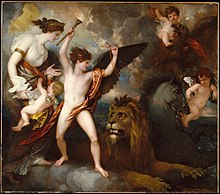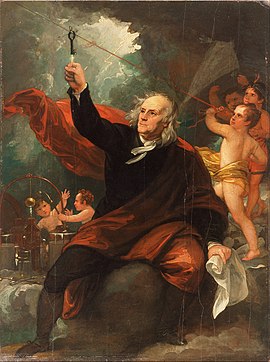User:Jfalchuk/sandbox
Benjamin Franklin Drawing Electricity from the Sky is a c. 1805 painting by Benjamin West depicting the American Founding Father Benjamin Franklin conducting his kite experiment in 1752 to ascertain the electrical nature of lighting. West composed his work using oil on a slate canvas. The dimensions of the painting measure 13.25 x 10 inches. The painting is one of nine of West's works that are exhibited at the Philadelphia Museum of Art, a gift of Mr. and Mrs. Wharton Sinkler in 1958.[1] The painting is an example of how West blends elements of both Neoclassicism and Romanticism. West paints Franklin as having supernatural abilities, as if he is harnessing the power of nature. At the same time, the painting has neoclassical artistic elements, such as depicting Franklin as being assisted in his experiment by Cherubs.[2] West used Cherubs in other paintings, such as Omnia Vincit Amor, to represent mankind being assisted by God. Franklin was known to have a relationship with West which influenced him to create this painting.

The Experiment[edit]
Franklin's Background[edit]
Franklin may be best remembered for his involvement in political science, as he was an integral member of the group of men known as the founding fathers that established the modern American government and asserted the United States' independence from England. He gained experience in science and engineering early on in his life, producing artisan crafts such as soap and candles. Self-taught in reading and writing, Franklin excelled above his peers in those fields. He dropped out of private grammar school after only one year of formal learning and instead turned his focus to the study of prose. Franklin would improve his writing by "reading [newspapers] over and over, copy and recopy them, and then try and recall them from memory" he accredits these exercises to help him establish advanced literary skills.[3] Franklin was a regular member of the Freemasons, a secret fraternal society, along with his fellow revolutionary colleague and first President of the United States, George Washington. In the 1740s, when Franklin was in his 40s, he began experimenting with electricity. Electricity was a scientific concept very much in the zeitgeist of the time. While Franklin was living in Philadelphia, he had an advisor, Peter Collinson, in London, which whom he would exchange results of the experiments he conducted. Franklin's name became recognized worldwide when Collinson published an 86-page book full of Franklin's experiments under the title Experiments and Observations on Electricity. Franklin went on to make numerous scientific discoveries, such as: "the distinction between insulators and conductors, a battery for storing electrical charges," as well as demonstrating "electricity was a single fluid with positive and negative charges" and "coining new English words for the new science of electricity--conductor, charge, discharge, condense, armature, and electrify."[4]
Conducting the Kite Experiment[edit]
West based his painting on a well-known experiment Franklin conducted in 1752. Franklin observed that lightning frequently destroyed homes by igniting those made of wood on fire. Franklin was determined to prove the presence of electricity in lightning, and he designed this experiment to do precisely that. Because he needed to be high in altitude to catch the lightning, Franklin's experiment depended on the completion of the construction of Christ's Church in Philadelphia. He planned to use the steeple's high vantage point to conduct his experiment. An alternative idea struck Franklin as he had found a way to bypass waiting for the construction by flying a kite instead. The experiment consisted of Franklin "attaching a metal key to a kite string and flying it during a thunderstorm."[5] Franklin conducted his experiment in private due to a myriad of factors, including the dangerous nature of the experiment and not wanting to disappoint the scientific community in the event of a failed experiment. He decided to experiment alongside his son at an empty field. Franklin documented that the clouds were "electrostatically charged," and he proved this by "touching his knuckle to the metal key on the string [of his kite], and a spark passed between his knuckle and the key."[6] His experiments led to the widespread adoption of lightning rods on tall buildings to draw electricity off the building and into the ground[7].
Description and Context[edit]
Painting[edit]
West depicts Franklin through a mythical lens that conveys the importance and superhuman stature for which many people saw Franklin. The thunderclouds and lightning in the sky combine to create a sublime scene conveying the danger associated with the experiment. Franklin is pictured fearlessly raising his hand into the stormy skies as the bright heavens contrast with the clouds and open above him. He heroically conducts the lightning from the key to his hand, putting scientific discovery above his health. West depicts Franklin with white hair appearing relatively old, as he is most popularly remembered and pictured in modern times. He is touching the key in his right hand and a scroll in his left. He has on a red cloak that is blowing in the wind as if it is a cape. To his right is a group of Cherubs "assisting" him in his experiment by holding the kite string and observing him. West dresses one of these Cherubs up in traditional Native American attire. Cherubs were traditionally used in Apotheosis paintings to glorify humans to God or Saint-like status. Directly to his right are another group of Cherubs tinkering around with a tool Franklin used to capture the lightning in jars. The string to which the key is attached juxtaposes "the drama of the diagonal" along with the "attitude of Franklin." Franklin's right arm, the Cherub to his right, and the Cherub to his left come together to form a triangle, the compositional foundation of the entire painting. West wants the viewers' eyes to immediately gravitate to his hand and the lightning key as the critical focus points. West accomplishes this effect by "clearly outlining the key" and "sputtering electricity even more energetically than the random bolt of lightning in the distance."[8] Franklin's head and gaze are fixated upwards looking beyond the canvas towards the heavens. These elements create the effect of Franklin calling on the forces on nature and the heavens in his experiment.

The painting is an example of a history painting, but as West had done in the past with his works, such as the Death of General Wolfe, he strays from the truth and embellishes many elements for added dramatic effect. West includes elements commonly used in Romantic paintings, such as religious motifs and sublime aesthetics. However, the Cherubs, message of heroism, masculinity, and the control, balance, and stability Franklin demonstrates in his pose and emotions in the painting are characteristic of neoclassical paintings. The blend of two styles allows West to achieve a mood of "order and comprehension in the midst of conflicting moods and mystery" and fuse to achieve an overarching sense of fantastical sublimeness.[9]
Straying From the Truth[edit]
Franklin was in his mid forties and with his son when he conducted the experiment. West paints him with white hair and wrinkly as the elderly man he is most remembered as appearing. West replaces Franklin's son with Cherubs all over the painting contributing to the experiment. He adds these dramatic elements to depict Franklin as "one of mankind's heroes, a new Prometheus, robbing the heavens of heir fire to protect human habitations on earth."[10] West's painting credits Franklin with putting America on the map in terms of scientific discovery and paints him in the heroic light in which he was remembered in America. The Statue of Young Benjamin Franklin with Kite is a more accurate to the truth depiction of how Franklin looked at the time of his experiment. In this plaster statue Franklin appears visibly younger and loses the wrinkles and features that West added to make him appear older.

West's Relationship with Franklin[edit]
Both historical figures called Philadelphia home and were known to have had an amicable relationship. West was born in Swarthmore, Pennsylvania, and Franklin moved to Pennsylvania in his early adulthood. The two bonded over their shared Pennsylvania roots but initially met in London. They became close enough that West nominated Franklin to be godfather to his second son. West decided to make the painting to celebrate the achievements of his friend in 1816 following Franklin's death in 1790. The painting in the Philadelphia Museum of Art was intended to be a study for a much larger painting that West planned to donate in honor of his friend to the hospital established by Franklin, the Philadelphia Hospital.[11]
Display[edit]
The painting is currently on display in the United States in the city Franklin called home for many years at the Philadelphia Museum of Art.
In Modern Culture[edit]
In 1965 the United States selected this painting to be featured as a model for their memorial stamp used to commemorate the 250 anniversary of Franklin's birth.[12]

See also[edit]
References[edit]
- ^ "Philadelphia Museum of Art - Collections Object : Benjamin Franklin Drawing Electricity from the Sky". philamuseum.org. Retrieved 2020-03-22.
- ^ D., D.; G., H. G.; G., F. P.; W., B. B.; C., W. H.; T., E. H.; H., C. S.; W., H. L. (1964). "[A Selection of Works Given to the Museum]". Philadelphia Museum of Art Bulletin. 60 (283/284): 7–37. doi:10.2307/3795199. ISSN 0031-7314.
- ^ Hart, D. G. (2021-06-11). "Benjamin Franklin". doi:10.1093/oso/9780198788997.001.0001.
{{cite journal}}: Cite journal requires|journal=(help) - ^ Hart, D. G. (2021-06-11). "Benjamin Franklin". doi:10.1093/oso/9780198788997.001.0001.
{{cite journal}}: Cite journal requires|journal=(help) - ^ H. Schneider, Stephen; L. Root, Terry; D. Mastrandrea, Michael (2011), "Franklin, Benjamin", Encyclopedia of Climate and Weather, Oxford University Press, doi:10.1093/acref/9780199765324.001.0001/acref-9780199765324-e-0189, ISBN 978-0-19-976532-4, retrieved 2022-11-22
{{citation}}: no-break space character in|last2=at position 3 (help); no-break space character in|last3=at position 3 (help); no-break space character in|last=at position 3 (help) - ^ H. Schneider, Stephen; L. Root, Terry; D. Mastrandrea, Michael (2011), "Franklin, Benjamin", Encyclopedia of Climate and Weather, Oxford University Press, doi:10.1093/acref/9780199765324.001.0001/acref-9780199765324-e-0189, ISBN 978-0-19-976532-4, retrieved 2022-11-22
{{citation}}: no-break space character in|last2=at position 3 (help); no-break space character in|last3=at position 3 (help); no-break space character in|last=at position 3 (help) - ^ Books, Market House Books Market House (2003-01-01), Books, Market House (ed.), "Franklin, Benjamin", A Dictionary of Scientists, Oxford University Press, doi:10.1093/acref/9780192800862.001.0001/acref-9780192800862-e-515, ISBN 978-0-19-280086-2, retrieved 2022-11-22
- ^ D., D.; G., H. G.; G., F. P.; W., B. B.; C., W. H.; T., E. H.; H., C. S.; W., H. L. (23/1964). "[A Selection of Works Given to the Museum]". Philadelphia Museum of Art Bulletin. 60 (283/284): 7. doi:10.2307/3795199.
{{cite journal}}: Check date values in:|date=(help) - ^ D., D.; G., H. G.; G., F. P.; W., B. B.; C., W. H.; T., E. H.; H., C. S.; W., H. L. (23/1964). "[A Selection of Works Given to the Museum]". Philadelphia Museum of Art Bulletin. 60 (283/284): 7. doi:10.2307/3795199.
{{cite journal}}: Check date values in:|date=(help) - ^ Vogel, Morris J. (1991). Cultural connections : museums and libraries of Philadelphia and the Delaware Valley. Katz Wheeler. Philadelphia: Temple University Press. ISBN 0-87722-840-X. OCLC 22664299.
- ^ "Benjamin Franklin Drawing Electricity from the Sky". philamuseum.org. Retrieved 2022-11-22.
- ^ Sellers, Charles Coleman; Peale, Charles Willson (1952). "Portraits and Miniatures by Charles Willson Peale". Transactions of the American Philosophical Society. 42 (1): 1. doi:10.2307/1005692. ISSN 0065-9746.
 | This is a user sandbox of Jfalchuk. You can use it for testing or practicing edits. This is not the sandbox where you should draft your assigned article for a dashboard.wikiedu.org course. To find the right sandbox for your assignment, visit your Dashboard course page and follow the Sandbox Draft link for your assigned article in the My Articles section. |

